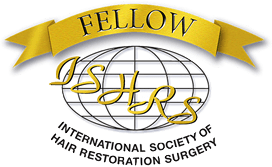Here we answer the most common questions about hair transplants.
How long does a hair transplant last?
Answer:
Performed correctly by a board-certified hair restoration specialist, hair transplant results can last a lifetime. Why is transplanted hair relatively permanent? What are the critical steps to getting the longest-lasting results from hair restoration procedures or treatments?
Hereditary hair loss, otherwise known as male and female pattern baldness, is a chronic and progressive condition–it gets worse with time without treatment. Hair follicles in the affected zones weaken and miniaturize over time and can be permanently lost unless treated at an early stage.
Have you ever noticed that even men with extensive hair loss tend to retain the hair around the sides and back of the scalp, often called the “monk’s ring?” This is because follicles that are located around the sides and the back of the scalp are resistant to hereditary hair loss effects. The good news is that when follicles are transplanted (relocated) from the back and sides of the scalp to thinning or balding areas, they retain their so-called “immunity” to the hereditary hair loss process.
If you are in the midst of mild to moderate male pattern hair loss, it’s critical to realize that the transplanted hair is relatively permanent, but your other hair is not. Ongoing medical therapy is highly recommended to preserve and protect your non-transplanted hair so that the risk of needing additional transplants is minimized.
Are there other factors besides heredity that influence hair growth and hair loss? Of course. Hair follicles are highly sensitive “barometers” of your overall wellness and health. This means that hair loss can be affected not just from your genetics, but also by stress, poor nutrition, poor sleep, unhealthy lifestyles including smoking, certain medications, or even auto-immune conditions can result in the weakening of hair follicles and eventually permanent hair loss.
It’s important to diagnose and treat your hair loss early in order to preserve the hair follicle function before it dies permanently. There are many hair restoration solutions available today. These include in-office treatments such as Platelet Rich Plasma (PRP) with Extracellular Matrix (ECM) and PDOgro™ or the use of implanted PDO Polydioxanone threads, as well as at-home treatments such as compounded prescription medications like Minoxidil and Finasteride, Low-level Laser Light Therapy, and Vitamins, Nutritionals & Nutraceuticals such as SuperBiotin, Nutrafol & ViviscalPRO. However, once a hair follicle is dead it can no longer be restored. The only option would then be to replace those follicles with a hair transplant.
Is a hair transplant permanent?
Answer:
Yes, a hair transplant can be permanent.
If you want your hair transplant results to last for the long term, look for an experienced, qualified, credentialed, full-time hair transplant surgeon who is certified by the American Board of Hair Restoration Surgery (ABHRS) and accepted by the International Alliance of Hair Restoration Surgeons (IAHRS). Before choosing your doctor, visit the clinic, read reviews, ask for before-and-after pictures, and most importantly, ask questions about how to achieve your desired results and what should be done to maintain them. Choose a doctor who takes the time to discuss a well-rounded treatment plan to preserve your non-transplanted hair and has a plan to help monitor and track your results with those regimens.
If you would like to know if you’re a candidate for hair transplant and discuss the truly viable options to protect your non-transplanted hair, schedule a consultation with Dr. Bauman, either in-office or virtually.
Click here to request a consultation
History of Hair Transplants
Hair transplant surgery has been popular since the 1950s but like many medical treatments has become more effective and more natural-looking over the years. The hair transplant that your father or grandfather may have gotten in the ’80s was likely a pluggy-looking, unnatural and painful procedure. It wasn’t until surgeons first started transplanting small grafts containing as little as one, two, or three hair follicles (also known as follicular units) in the mid-90’s that hair transplants started giving natural-looking results with the advent of the technique called Follicular Unit Transplantation (FUT). For the first time, microsurgical follicular unit grafting allowed artistic surgeons to precisely control the angle, orientation, and position of each individual hair follicle being implanted, so that the results could look completely 100% natural and undetectable. [Hair transplant procedures that look unnatural are typically the result of outdated techniques or surgeons who transplant hair without regard to natural patterns of hair growth.]
In a traditional FUT procedure, a surgeon removes a strip of hair-bearing skin from the back and side of your head which is then given to a team of technicians to dissect the individual grafts containing follicular units. The surgeon will then suture or staple your scalp closed where the strip was taken. Once the grafts have been dissected from the strip, they’re re-inserted into the balding areas of your scalp. While a FUT procedure can look completely natural, the main drawback is that the patient is left with a permanent “linear scar” where the strip was taken. Numerous factors determine the visibility of the permanent scar, including the skill of the surgeon, size of the strip removed, healing ability etc. It is not uncommon for patients to require strong narcotic pain medication for weeks after a traditional FUT procedure and be instructed to refrain from physical activity for a month or more to ensure that the linear scar does not stretch. Many patients have trouble hiding their old linear scars and are limited in terms of their hairstyles. [Learn more about how we can repair and camouflage an old linear FUT scar.]
Today’s State-of-the-Art Hair Transplants
Today’s leading-edge hair transplants use a minimally-invasive technique called Follicular Unit Extraction (FUE). FUE hair transplants are performed by harvesting individual follicular units 1-by-1 from the donor area, typically the sides and back of the scalp, and implanting them into the areas which are thinning or balding. FUE is less invasive than FUT strip or linear harvesting, and requires no scalpel, no stitches, or staples in the Donor Area, and leaves absolutely NO LINEAR SCAR.
Is FUE more or less effective than FUT?
Years ago, surgeons who preferred the traditional FUT approach were quick to say “FUT moves more hair and is more efficient.” But as FUE techniques were refined and improved by FUE specialists and surgical pioneers, we learned that FUE can be even more effective than FUT when it comes to the transplantation of hair.
Of course, because FUE is a more delicate and refined technique, it can take longer to undergo a procedure. But new advanced devices such as NeoGraft, SmartGraft, Trivellini-Mamba, as well as the ARTAS robotic-assisted hair transplant device, have made FUE dramatically more efficient. At Bauman Medical, depending on the number of FUE grafts harvested and other factors, procedures can sometimes require consecutive procedure days to complete–especially if more than 2,000 grafts are involved.
What is FUE recovery like compared to FUT transplants?
Recovery from FUE procedures is more comfortable and less restrictive than with FUT linear harvesting because no strip of skin has been removed so there’s no tension on the skin and no large wound with stitches/staples to heal. The vast majority of patients require absolutely NO strong pain medications during their recovery and can return to non-impact athletic physical activity in just several days.
Improvements in anesthetic medications and techniques have now made hair transplantation a virtually painless process, one that is easily undertaken comfortably while watching movies or listening to music. Recovery from FUE is shorter, less restricted and considerably more comfortable than a traditional FUT procedure, typically requiring little if any strong pain medications after the first day.
Cosmetic recovery of the FUE donor area and recipient areas typically takes about a week. Within 2 weeks of an FUE procedure, the newly transplanted follicles will enter a resting phase and shed their hair shafts. This is completely normal. Approximately 6-12 weeks later, the transplanted follicles will begin to grow new hair. It takes about 4-6 months before you begin to see noticeable changes in your hair growth and a year until the full results of the transplant can be fully appreciated. Since these healthy hair follicles transplanted from the donor area are not susceptible to male or female pattern hair loss, the transplanted hair should last a lifetime. This varies from person to person based on their hair type, age, and lifestyle. While transplanted hair can last a lifetime, it’s important to note that ongoing treatments will be necessary to keep your remaining hair healthy and full.
Today’s hair transplants, if performed correctly by a qualified, certified hair transplant specialist and his or her specialized team, are permanent, safe, and look completely natural. Regardless of the extent of your hair loss, your age, or gender, you should go over your options by talking with your doctor. Today’s hair transplants can help to reclaim lost confidence by helping you look good and feel great!




 FDA Concerns Over Topical Finasteride? Explore Safer, Holistic Hair Loss Treatments
FDA Concerns Over Topical Finasteride? Explore Safer, Holistic Hair Loss Treatments How to relax your way to better hair
How to relax your way to better hair VIDEO: Minimally Invasive FUE Hair Transplant FAQ
VIDEO: Minimally Invasive FUE Hair Transplant FAQ Dr. Alan J. Bauman, M.D.Hair Loss & Hair Transplant ExpertBoca Raton, FL
Dr. Alan J. Bauman, M.D.Hair Loss & Hair Transplant ExpertBoca Raton, FL






